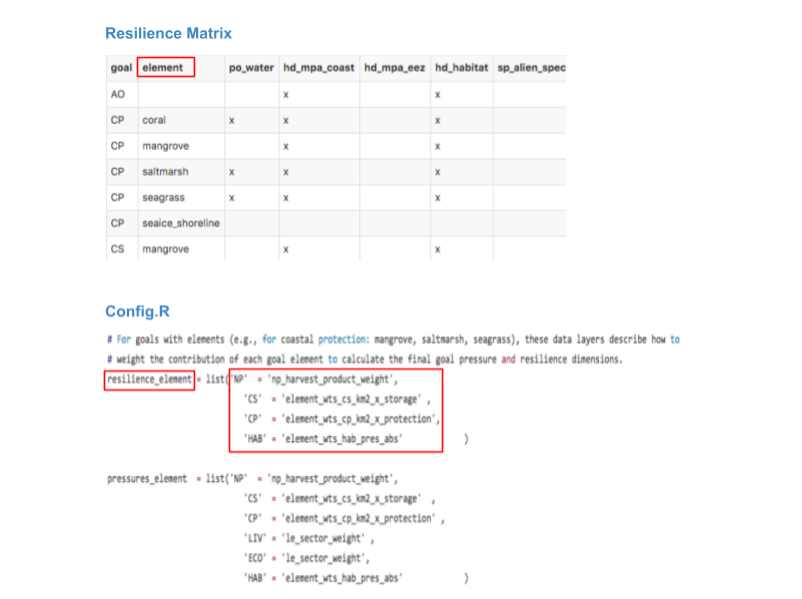-
Notifications
You must be signed in to change notification settings - Fork 6
/
pressures_resilience.Rmd
299 lines (171 loc) · 31.6 KB
/
pressures_resilience.Rmd
1
2
3
4
5
6
7
8
9
10
11
12
13
14
15
16
17
18
19
20
21
22
23
24
25
26
27
28
29
30
31
32
33
34
35
36
37
38
39
40
41
42
43
44
45
46
47
48
49
50
51
52
53
54
55
56
57
58
59
60
61
62
63
64
65
66
67
68
69
70
71
72
73
74
75
76
77
78
79
80
81
82
83
84
85
86
87
88
89
90
91
92
93
94
95
96
97
98
99
100
101
102
103
104
105
106
107
108
109
110
111
112
113
114
115
116
117
118
119
120
121
122
123
124
125
126
127
128
129
130
131
132
133
134
135
136
137
138
139
140
141
142
143
144
145
146
147
148
149
150
151
152
153
154
155
156
157
158
159
160
161
162
163
164
165
166
167
168
169
170
171
172
173
174
175
176
177
178
179
180
181
182
183
184
185
186
187
188
189
190
191
192
193
194
195
196
197
198
199
200
201
202
203
204
205
206
207
208
209
210
211
212
213
214
215
216
217
218
219
220
221
222
223
224
225
226
227
228
229
230
231
232
233
234
235
236
237
238
239
240
241
242
243
244
245
246
247
248
249
250
251
252
253
254
255
256
257
258
259
260
261
262
263
264
265
266
267
268
269
270
271
272
273
274
275
276
277
278
279
280
281
282
283
284
285
286
287
288
289
290
291
292
293
294
295
296
297
298
# Pressures and Resilience {#press_resil}
The purpose of this chapter is to introduce you to updating pressures and resilience information for calculating OHI scores. This is a 2-hour hands-on training: you will be following along on your own computer and working with a copy of the demonstration repository that is used throughout this chapter.
## Overview
Pressures and Resilience are two of the four dimensions used to evaluate each goal or sub-goal, along with Status and Trend.
The OHI R package `ohicore` will calculate pressures and resilience scores for you using information from pressures and resilience data layers and matrices. `ohicore` takes the data layers listed in the matrix (they are data layers similar to those for status: they need values for every region in your assessment) and calculates pressures and resilience scores. These scores will then affect the goals indicated in the matrix with a 1, 2, or 3 weighting.
This means that you are responsible for updating the data within pressures and resilience layers so they best represent your assessment. Additionally, you can add and remove layers from the matrix, and change which goals they affect.
<!---
### Prerequisites
Before the training, please make sure you have done the following:
1. Have up-to-date versions of `R` and RStudio and have RStudio configured with Git/GitHub
- https://cloud.r-project.org
- http://www.rstudio.com/download
- http://happygitwithr.com/rstudio-git-github.html
1. Fork the **toolbox-demo** repository into your own GitHub account by going to https://github.com/OHI-Science/toolbox-demo, clicking "Fork" in the upper right corner, and selecting your account
1. Clone the **toolbox-demo** repo from your GitHub account into RStudio into a folder called "github" in your home directory (filepath "~/github")
1. Get comfortable: be set up with two screens if possible. You will be following along in RStudio on your own computer while also watching an instructor's screen or following this tutorial.
--->
## Identifying indicators
Ideally, every pressure with an identified strong impact should have a corresponding resilience measure. The rationale is that as resilience in the study area increase (for instance, by improving environmental regulations), they would balance out and eventually neutralize the pressures. In time, this would lead to an increase in a goal’s status, and therefore the overall goal or sub-goal score. By including regulatory responses in your assessment, you ensure that the actions taken in your country are relevant to ocean health.
In practice, however, the pressures and resilience measures you include in your assessment will be highly determined by data availability. It is best to first consider what pressures are acting in your study area and then determine if data are available to measure them. You should also decide if the pressures data included in the global assessment are relevant for your assessment and determine if local data better capture pressures for all the regions in your study area. When considering resilience measures, look for regulations or indicators that could be encompassed in one of the pressures categories.
See Chapter \@ref(gathering-data) for more details.
## Pressures
<!---
- what the matrix means, it's a 3D matrix
- that you still need to data for each indicator in the matrix.
- to substitute data behind an existing data layer, proceed as in calcs_basic
- to add a new layer, you'll need to prepare data, save in layers, register in layers.csv and scenario_data_years.csv, but then also: in the matrix, identify which goals are affected. For global, this was based on many references (see S28 in original Halpern et al. 2012 SOM): you can use this as well, or references of your own. Finally, you'll need to weight them.
--->
The Toolbox calculates pressures in five ecological pressure categories (e.g., pollution, habitat destruction, fishing pressure, species pollution, and climate change) and one social pressure category (e.g. strength of governance). Under each category, there can be multiple pressure data layers. For example, the “pollution” category could include pathogen, nutrients, and chemical pollution.
There are two types of pressures data you need to provide for the toolbox: *data layers for each pressure* and the *pressure matrix*.
### Pressures data layers
The pressures you will include in your assessment will depend on what is important in your study area and what data are available. If local pressures data are not available, you may default to using data from the global assessment, but this means in most cases that you will not have different information for each region. You will determine the weight ranks required in the pressures matrix only after you have identified the data you will include.
The following steps outline the process of how to identify pressures in your assessment. The steps are iterative; return to previous steps to ensure you capture all important pressures in your study area:
1. Begin by exploring pressures important to your study area. What are big stressors acting along your coastlines?
2. Are data available to measure these stressors? If not, are other indirect measures or proxies available to represent these stressors?
3. Evaluate the pressures included in the global assessment. For example, if there is no mariculture in your study area, you could remove pressures data layers that only affect this goal (i.e. genetic escapes).
4. Also while examining the pressures included in the global assessment, are all of them relevant? Are there local data that can be substituted in the place of global data? Can you keep some of the global pressures?
5. Determine the pressure category for any additional stressors in your study area, and add it to the pressures matrix.
6. When all stressors are included in the pressures matrix, determine which goals they affect. Then, for each goal, determine the weight rankings of all stressors. Use literature and expert judgement to determine this.
7. Prepare each pressure data layer as described in \@ref(prep-data) only after steps 1-6 are completed. In addition to the proper formatting for the Toolbox, pressures data must be rescaled (normalized) on a unitless scale from 0 - 1, where 0 is no stressor at all and 1 is the highest possible value for the stressor. You will have to determine how to rescale the data, whether it is based on the highest value in the data range or other methods (like using the 95th quantile as a reference point).
### Pressures matrix
Independent from the pressures data layers, you will modify the Pressures Matrix table that establishes the relationships between stressors and goals, i.e. how each pressure measure affects each goal, or distinct components of a goal (e.g. an individual habitat type or natural product). It uses a rank from 1-3 to weight how strongly a given pressure affects a goal or sub-goal relative to all the other pressures affecting it.
The rank weights used in the pressures matrix were determined by Halpern et al. 2012 (Nature) based on scientific literature and expert opinion (see Supplemental Table S28 of Halpern et al. 2012). For example, commercial high and low bycatch are categorical values that were set based on fishing gear type. This began as a list of gear types used, producing a range of potential bycatch frequencies (from local reports when possible), which can be rescaled. In the pressures matrix ranks are categorized as follows:
3 = high pressure
2 = medium pressure
1 = low pressure
Scores from 1-3 are given to rank the importance of each pressure. Only values of 2 or 3 require that a resilience layer be activated when calculating the goal scores.
Stressors that have no impact are left blank in the matrix rather than being assigned a rank of zero, which would affect the average score. Pressures are ranked rather than being represented as a binary (yes/no) measure because the range of consequence of different pressures on each goal can be quite large, and to classify all those pressures as a simple ‘yes’ would give too much influence to the weakest stressors. For example, food provision could be most heavily impacted by unsustainable, high-bycatch fishing, but pollution does have some impact on fish populations. Without a weighting system, these stressors would be treated equally in their impact on the food provision goal. Assigning the weights for stressors is pretty subjective to the other stressors, so it will be up to you to use your best judgement to assign weights.
### How to modify Pressures Matrix and Categories in the Toolbox
Your team will identify if any pressures layers should be added to the pressures matrix, and if so, which goals the pressure affects and what weight they should have. We can use the toolbox-demo repository that you forked earlier as a reference. You can transfer this information in pressures_matrix.csv (located in the *toolbox-demo/region_2017/conf* folder). It is important to note that the matrix identifies the pressures relevant to each goal, and which weight will be applied in the calculation. Each pressure is a data layer, located in the toolbox-demo/region_2017/layers folder. This means that pressure layers need information for each region in the study area, and some layers will need to be updated with local data. In modifying pressures, you will need to consider whether data layers can be updated or added, and whether data layers map onto goals appropriately in the local context. If you add a pressure layer to the layers folder, you will need to add the same layer to the pressures_matrix.csv, and vice-versa.
Adding a new pressure to the pressures matrix requires the following steps:
Create new pressure layer(s) and save in the layers folder
Register pressure layer(s) in layers.csv
Register in pressures_categories.csv
Register in pressures_matrix.csv, identify the goals affected and set the weights
Modify config.R for goals that have elements
### Create the new pressure layers and save in the layers folder
If you create a new data layer, give it a short but descriptive name that also includes a prefix that signifies the pressure category (for example: po_ for the pollution category). There are five physical categories and one social category:
po_ = pollution
hd_ = habitat destruction
fp_ = fishing pressure
sp_ = species pollution
cc_ = climate change
ss_ = social pressure
So for example, po_trash is a pollution layer with trash on beaches, and sp_alien is species pollution due to alien (invasive) species.
These new layers will have scores from 0 to 1, with values for each region in your study area, and will be saved in the layers folder.
### Register the new pressure layers in layers.csv'
Let’s say you were adding two new pressures layers for desalination to the pressures matrix. You would then add two new rows in layers.csv, and register the new pressure layers by filling out the first eight columns for po_desal_in, and po_desal_out.

### Register in pressures_categories.csv
This is a table to record the name of each pressures data layer, its category, and subcategory. Each data layer name is the same name that is saved in the layers folder and is registered in layers.csv. Each layer falls under one of two categories - ecological or social pressures, and one of several subcategories to further represent the origin of the pressure (e.g. climate change, fishing, etc), which is also indicated by a prefix of each data layer name.
Each pressure category is calculated separately before being combined with the others, so it is important to register the new pressure with the appropriate category prefix decided by your regional assessment team. In our example, we would add two rows for po_desal_in and po_desal_out.
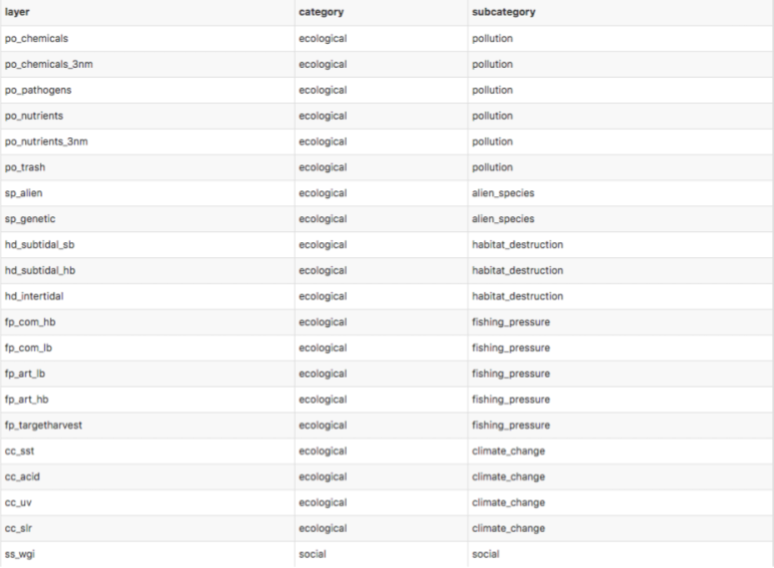
### Register in pressures_matrix.csv
To have the pressures act on different goals, we must register the pressures in the matrix. pressures_matrix.csv identifies the different types of ocean pressures with the goals that they affect. Adding a new pressures layer to pressures_matrix.csv requires adding a new column with the pressure layer name.
The columns element (and element_name) record habitat types for habitat-specific goals (eg. CS and CP) and industrial sectors for economy-based goals (eg. ECO).
The rest of the column headers of the pressures matrix are the layer names of the pressures layer file that are saved in the layers folder and registered in layers.csv, matching what is recorded in the pressures_categories.csv.
NOTE: Make sure to remove unused pressures layers from the layers.csv, pressures_matrix.csv and pressures_categories.csv. Otherwise ohicore will search for all the layers registered in those files and calculations will halt if it encounters pressure layers that do not exist.
### Identify the goals affected and set the weighting
This step also requires transferring prior decisions into pressures_matrix.csv. Mark which goals are affected by this new pressure, and then set the weighting. Pressures weighting by goal should be based on scientific literature and expert opinion (3 = highly influential pressure, 2 = moderately influential pressure, 1 = not very influential pressure). Remember that the rankings in the pressures matrix are separate from the actual data within the pressures data layers. The rankings ensure that within a particular goal (e.g. within a row of the pressures matrix), the stressors that more strongly influence the goal’s delivery have a larger contribution to that goal’s overall pressure score. Therefore, the rankings are assigned independently of the actual pressure scores, and only determine their importance within the calculations.
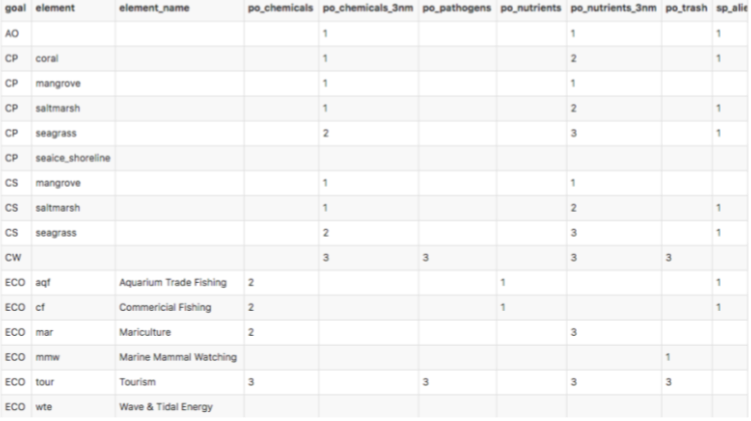
### Modify config.R for goals with multiple elements
If a goal has multiple elements (eg. CS has multiple habitats), as reflected in pressures_matrix.csv where the columns element (and element_name) are filled, you need to update config.R in conf folder, as shown below:
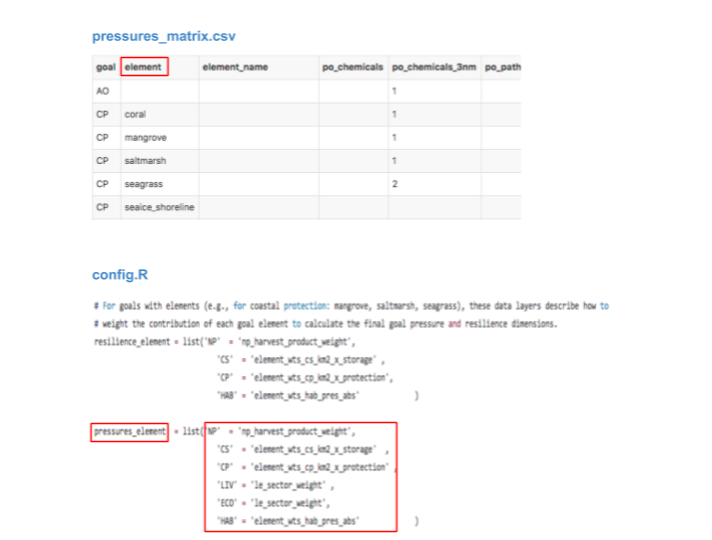
The highlighted files are data layers necessary to calculate pressures for each of the goals with components. They contain weights, or relative contribution from each element to the total pressures of the goal. These weights are calculated separately in the data prep folder for each goal, and saved and registered as you would for any data layer. How to calculate these data layers can be found in the description column of layers.csv.
## Resilience
In addition to this chapter, these resources are available:
- [ResilienceSlides.pptx](https://github.com/OHI-Science/toolbox-training/blob/master/downloads/ResilienceSlides.pptx)
- [ResilienceMeasures_BritishColumbia.pdf](https://github.com/OHI-Science/toolbox-training/blob/master/downloads/ResilienceMeasures_BritishColumbia.pdf)
### How to identify and quantify resilience
Resilience is included in OHI as the sum of the ecological factors and social initiatives (policies, laws, etc.) that can positively affect goal scores by reducing or eliminating pressures. The addition of new pressure layers may therefore warrant the addition of new resilience layers that were not previously relevant. Similarly, the removal of pressure layers may warrant the removal of now irrelevant resilience layers. You can then transfer this information into resilience_matrix.csv and resilience_categories.csv (located in the [toolbox-demo]/[region2017]/conf folder in the [toolbox-demo repository](https://github.com/OHI-Science/toolbox-demo)).
Ideally, each pressure included in the pressures matrix should have a corresponding resilience measure, which is meant to ‘balance’ the pressures that negatively effects on ocean health. The OHI considers resilience in two categories: **ecological resilience** to address ecological pressures, and **social resilience** to estimate how a region may be able to respond to or prevent environmental challenges. Additionally, **goal-specific regulations** are intended to address ecological pressures, and are measured as laws, regulations, and other institutional measures related to a specific goal. Ideally, for any resilience measure, you would have three tiers of information:
- **Existence of regulations:** Are regulations in place to appropriately address the ecological pressure?
- **Implementation and enforcement:** Have these regulations been appropriately implemented and are there enforcement mechanisms in place?
- **Effectiveness and compliance:** How effective have the regulations been at mitigating these pressures and is there compliance with these regulations?
Ideally, information would exist for these three tiers, and you would be able to weight the resilience measure based on the quality of the information as 1 (existence of regulation), 2 (implementation and enforcement), or 3 (effectiveness and compliance). This approach is different from the way ranks are assigned in pressures, which is based on impact. However, in most cases, information is not available for these three tiers: often, the existence of regulations is all that is available, and this does not always vary by region. In some cases, you may want to consider building your own set of indicators to determine **implementation and enforcement** and **effectiveness and compliance**.
#### Ideal Approach
Ideally, assessments of social resilience would include national-level and as well as local rules and other relevant institutional mechanisms that are meant to safeguard ocean health. In Global assessments, the focus has been on international treaties and indices, so your region may likely have more localized information and you can update the resilience matrix and resilience layers. There would also be information as to their effectiveness and enforcement. Information on social norms and community (and other local-scale) institutions (such as tenure or use rights) that influence resource use and management would be useful too.
#### Practical Considerations
In practical terms, resilience is hard to define and finding data can be difficult. It is often difficult to find regulations and indicators that would directly ‘balance’ individual stressors, but it is worth the effort to explore what information is available in the local context and how it could be included as resilience measures. You may be able to construct your own set of indicators for resilience (particularly social resilience) using proxy data. Your team may have to get creative to develop appropriate assessment measures here. It can be metrically be defined as presence-versus-absence (value of zero or one), or on a scale (value between zero and one) if the measure is an assessment or score. For instance in global assessments, resilience measures that were counted in the socio-economic resilience class of data came from the World Governance Indicators (http://govindicators.org). In a regional context, however, a more appropriate data layer might be a local governance index of some kind, preferably developed by a reputable organization using credible methods.
When available, national-level data are preferable to global-level data for your assessment. These include national laws on the environment, or protection of the marine environment or rivers that lead to coastal waters. National laws include things like the Clean Water Act (CWA) and the Endangered Species Act (ESA) in the U.S., or the national implementations of the E.U. Water Framework Directive. National actions can also be broadened beyond just legislation to include administrative procedures such as those involving permits, licenses, court cases, administrative action, and compliance mechanisms.
State or province-level laws provide more regionally-specific information and thus work well for assessments. This would involve looking at the same types of laws and policies that exist on the national level, but specifically incorporating those that have been tailored to fit the needs of a particular sub-national area. This includes things such as California’s state-level California Environmental Quality Act (CEQA), or the California Ocean Protection Act (COPA), which have laws designed specifically to protect California’s environment. This would tell you more relevant information than using data from a national or international law. Local level regulations will usually provide you with the most accurate information for your assessment in order to tailor it best to the local context.
#### Scoring: Turning Qualitative into Quantitative
There are several ways to turn the qualitative information of regulations and social actions into quantitative metrics for analysis. A robust way is to give credit for different aspects of the resilience measures. In addition to a score for having the law, policy, or action, in place, it is possible to gauge the effectiveness of that activity.
The simplest way is to give credit for having a resilience measure in place. This means assigning a binary score of zero or one for “presence” versus “absence” of the resilience measure. For international conventions, this can be done by assigning a value of 1 for having signed a convention. A more rigorous score can be given for countries that have further ratified a convention in addition to signing it; this is one way to further differentiate scores. This can be done by seeing if a country has signed and ratified CITES.
> For example, if you were trying to find out if there are regulations in place that guide fishing pressure, you could look see if regulations exist for trawl-fishing limitations, or see if there are regulations for fish size, length, or if there are any seasonal restrictions. Another option would be to see if formal stock assessments exist for commercially-fished species.
A further step is to assess how well those measures are being complied with. This will give you more robust way is to assess how well a resilience mechanism is working to maintain the integrity of the regulation and thereby the ecosystem.
> For example, once you have found out whether regulations for fishing pressure exist, you would then try to find values for compliance with these regulations. These could be raw data or calculated statistics such as rate of compliance or proportion of compliance. It should answer the question, “Are there indicators of compliance with fishing pressure guidelines”?
A subsequent, and final, step to creating a robust resilience assessment is to determine whether there are enforcement mechanisms in place to deal with non-compliance of the regulations. This is because a regulation is only as good as its implementation, and having both enforcement and compliance actions in place would reinforce the regulation and make it more effective.
> For example, in the case of fishing pressures, a further look into available data could lead you learn whether there are reported values of inspector visits and enforcement coverage of permitted facilities. Or you could look at reported numbers of enforcement actions in response to non-compliance. Further, you could also see if there are fines that have been paid or exist in association with non-compliance.
#### Data sources
Environmental laws and policies offer tangible information on resilience. The most common type of environmental regulations come from administrative law, such as pollution regulation of various kinds. Land-use law is also important to the integration of social and ecosystem issues, so finding zoning laws relevant for coastal areas could be useful, and so could finding whether or not a region requires environmental impact statements before allowing construction for either coastal land or for marine planning. Other kinds of law some countries include court cases settling disputes or requiring reparation of pollution damages, for example.
Resilience also goes beyond just the law, however. Insurance policies present another option, for instance. Coastal areas are increasingly requiring climate-related insurance in some countries, and so the existence of such markets in a vulnerable area would be an example of a climate change resilience measure. Social initiatives also present another way to tackle resilience. There might be a beach clean-up day, a percentage of the refuse material that is recycled by the population, or some other social factor that reduces trash inputs into the ocean. A local law banning plastic bags is another way that local jurisdictions control plastic trash.
#### Incorporating local resilience measures in your assessment
1. Begin by exploring how resilience could be measured in your study area. What laws and regulations are in place that could provide resilience to ocean health?
2. Are there locally-developed indices that capture social or ecological resilience? Is there information about how each region in your study area are implementing or enforcing the laws?
3. Evaluate the resilience measures are included in the global assessment. Are all of them relevant? Are there local data that can be substituted in the place of global data? Are there resilience measures that should be excluded entirely?
4. Assign the resilience measure to the appropriate goal. Since resilience measures are in response to pressures that have a weight rank of 2 or 3 effect on a certain goal, determining which goals ecological and social resilience measures effect follows the same pattern as the pressures matrix. For goal-specific resilience measures, assign the resilience measure to the appropriate goal.
5. Prepare each resilience data layer as described in the \@ref(prep-data) section only after steps 1-4 are completed. In addition to the proper formatting for the Toolbox, resilience data must be rescaled (normalized) on a unitless scale from 0 - 1. You will have to determine how to rescale the data, whether it is based on the highest value in the data range or other methods (such as using the 95th quantile as your reference point).
#### Including resilience measures from global assessments
Remember that local measures are far more appropriate than those included in global assessments, which likely do not reflect local management targets. However, international data were used in the global assessments that are available to you if you cannot find better local data:
Table of resilience layers and descriptions
|layer | name |
|------ | ----- |
|alien_species | Alien species|
|cites | Resilience from commitment to CITES|
|fishing_v1 | CBD survey: coastal fishing v1|
|fishing_v1_eez | CBD survey: ocean fishing v1|
|fishing_v2_eez | CBD survey: ocean fishing v2|
|fishing_v3 CBD | survey: coastal fishing v3|
|fishing_v3_eez | CBD survey: ocean fishing v3|
|habitat | CBD survey: habitat|
|habitat_combo | CBD survey: coastal habitat|
|habitat_combo_eez | CBD survey: ocean habitat|
|li_gci | GCI: competitiveness in achieving sustained economic prosperity|
|li_sector_evenness | Sector evenness as a measure of economic diversity|
|mariculture | CBD survey: mariculture|
|msi_gov | MSI sustainability and regulations|
|species_diversity | Ocean ecological integrity|
|species_diversity_3nm | Coastal ecological integrity|
|tourism | CBD survey: tourism|
|water | CBD survey: water|
|wgi_all | Strength of governance indicated with the WGI|
* CBD = Convention on Biological Diversity; GCI = Global Competitiveness Index; MSI = Mariculture Sustainability Index; WGI = World Governance Indicators.
### How to modify Resilience Matrix and Categories in the Toolbox
Adding a new resilience layer to the resilience matrix requires the following steps:
1. Create new resilience layer(s) and save in the **layers** folder
2. Register resilience layer(s) in **layers.csv**
3. Register resilience layer(s) in **resiliences_categories.csv**
4. Set the resilience category
5. Set the weights
6. Register resilience layer(s) in **resiliences_matrix.csv**
7. Identify the goals affected
8. Modify **config.R** for goals that have elements
#### Create new resilience layers, save in layers folder and register in layers.csv
This process is similar to what you have done for the pressures data layers. Prefixes are also used for these layers, see layer and subcategory columns snapshot of the Resilience Categories below for more details.
#### Register in Resilience Categories
resilience_categories.csv records general information on each resilience data layer. The full list of layers included in the global resilience matrix are shown in the resilience_matrix.csv:
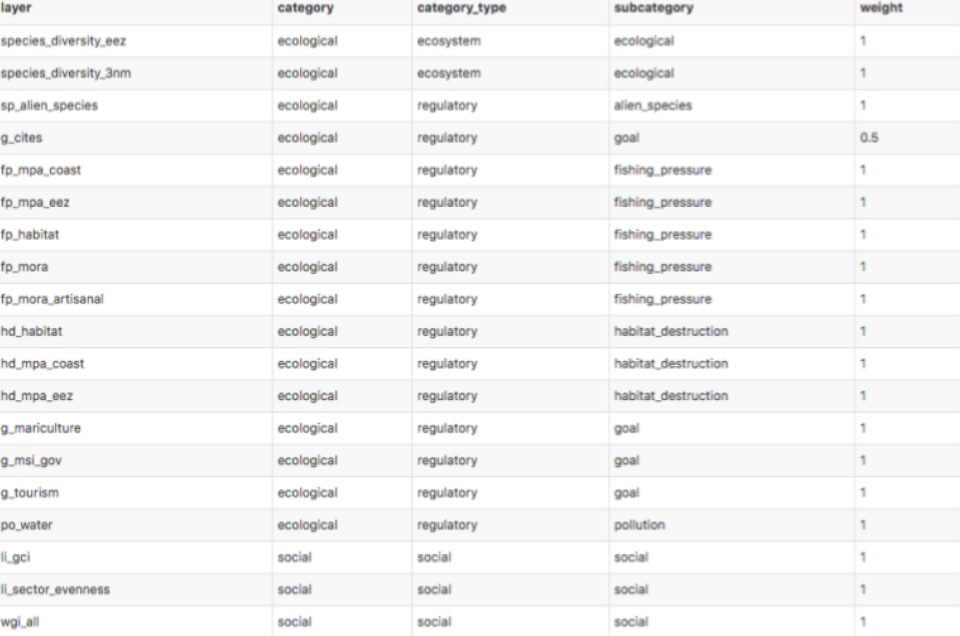
Each resilience layer indicated in the table is a data layer just like all the other data layers you have formatted, saved in the layers folder, and registered on layers.csv. Each layer falls under a category of resilience - ecological or social, and one of three category_type - ecosystem, regulatory, or social, representing the origin of each resilience layer. The subcategory column indicates what specific pressure each layer of resilience is targeted at. The prefix of each data layer corresponds to its subcategory (eg. po, li, g, etc).
In addition, the weight column represents level of institutional governance. Governance is a function of 1) institutional structures that address the intended objective (eg. whether appropriate laws/regulations exist, etc), 2) a clear process for implementing the institution is in place, and 3) whether the institution has been effective at meeting stated objectives. At global scales it is very difficult to assess these three elements; we usually only had information on whether institutions exist. However, in some cases we had detailed information on institutions that enabled us to assess whether they would contribute to effective management, and thus, increased ocean health. In those latter cases, we gave more weight to those measures. In the resilience_categories.csv pre-loaded from OHI-Global 2016 to your repository, there are two weights assigned to each layer:
- 0.5 means that a law or regulation exists, or a country has signed an appropriate treaty
- 1 means that there are evidence of implementation of the laws and regulations.
However, you can redefine how the weights are set to available information in your regions.
#### Register in Resilience Matrix
resilience_matrix.csv maps the different types of resilience (columns) with the goals that they affect (rows). Whether a resilience layer has any influence on a goal, or an element of the goal, is represented by an x, or its absence. For example, po_water layer is relevant to the salt marsh element of CP goal, as shown by the x in the cell. On the other hand, that data layer does not apply to the mangrove element of the same goal, hence the absence of an x.
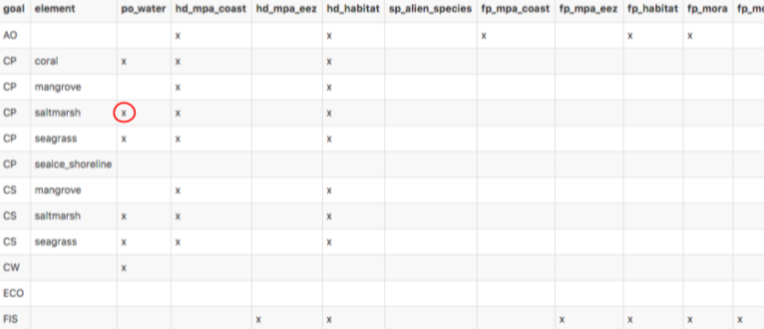
New resilience layers may be added to resilience_matrix.csv based on finer-scale local information either in response to a new pressures layer, or as a new independent measure. Any added layer must be associated with a pressures layer that has a weight of 2 or 3 in the OHI framework so that resilience measures can mitigate pressures in each region.
#### How to modify config.r for goals with multiple elements
If a goal has multiple elements, as shown in pressures_matrix.csv, you need to update config.r in conf folder, as shown below:
